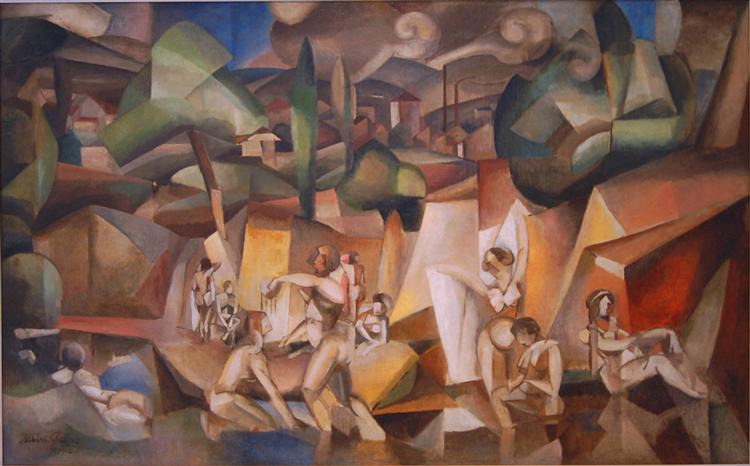Description
Albert Gleize's "The Swimmers" (1912) is erected as a notable example of Cubist art, a style that broke with traditional representation conventions and sought a new way of capturing reality. Gleizes, one of the pioneers of Cubism, is dedicated in this painting to explore the interaction between the movement, the human figure and the aquatic environment, reflecting on the experience of the body in space. At first glance, there is a structure of geometric shapes and plans that are intertwined, generating a feeling of dynamism and fluidity, in tune with the issue of swimming.
The use of color is essential in this work; Bluish tones evoke water, while the figures are presented in a palette that covers from yellow to the terracotta. This chromatic choice not only suggests the depth and transparency of water, but also communicates a vibrant and cheerful atmosphere, in line with the playful activity of swimming. Human forms, although recognizable, are stripped of detailed anatomical characteristics. Gleizes presents them more abstractly, emphasizing the essence of the movement and the act of swimming instead of focusing on the individuality of each figure. These figures seem to float in a synchronized dance, which can be interpreted as a celebration of the freedom and vitality of the body in the aquatic environment.
The composition of the work is equally captivating. The different angles from which the figures are presented suggest a three -dimensionality that distances itself from the conventional pictorial representation. When observing "the swimmers", the viewer is invited to feel the vivacity of the scene, as well as to contemplate the freedom that the experience of swimming can provide. The work can be seen as a study of the movement, where each figure seems in constant goal of blurring its shape and merging with water in an imaginary corner.
It is important to point out the context in which this work occurred. During the first years of the twentieth century, the Cubism of Gleizes and other artists not only dealt with the exploration of the form and color, but also sought to reflect the complexity of modern life. "The swimmers" can be seen as a microcosm of the creative possibilities of that moment, evoking both the energy of the aquatic environment and the search for new forms of visual communication. This work dialogues with other contemporary pieces within the same style, where the treatment of the human figure becomes a recurrent phenomenon; The body becomes a field of experimentation on shapes, light and shadow.
Thus, "swimmers" sits firmly in art history as a clear exponent of Cubism, characterized by its innovative approach and their ability to transform everyday experiences into a rich visual expression. Albert Gleizes, through this work, offers us a window towards modernity, inviting us to reinterpret the movement and gestures of the human body in harmony with its surroundings. The work not only retains an aesthetic sense, but also confronts us with the idea that art can explore human experiences as universal as game and freedom.
KUADROS ©, a famous paint on your wall.
Reproductions of paintings handmade oil, with the quality of professional artists and the distinctive seal of KUADROS ©.
Art reproduction service with satisfaction guarantee. If you are not completely satisfied with the replica of your painting, we refund your money 100%.

